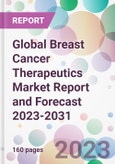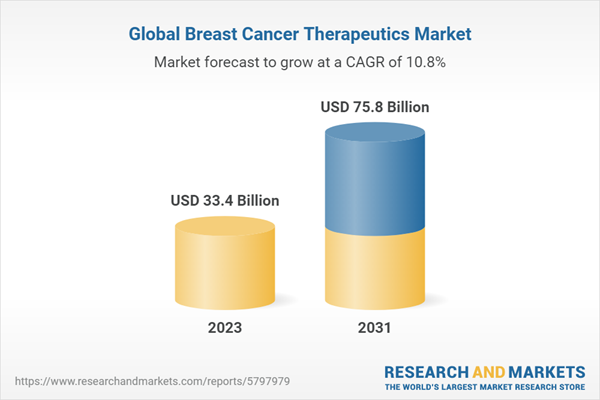The global breast cancer therapeutics market size was USD 30.2 billion in 2022, driven by the rising incidence of breast cancer across the globe. The market size is anticipated to grow at a CAGR of 10.8% during the forecast period of 2023-2031 to achieve a value of USD 75.8 billion by 2031.
The introduction of breast cancer therapeutics has revolutionized the way we approach the treatment of this condition. The development of various treatment modalities, including surgery, radiation therapy, chemotherapy, hormone therapy, targeted therapy, and immunotherapy, has provided healthcare professionals with a diverse arsenal of options to combat breast cancer.
The market for breast cancer therapeutics is driven by several factors. Firstly, the rising incidence of breast cancer, coupled with the growing awareness and early detection efforts, has led to an increased demand for effective treatment options. Secondly, advancements in medical research and technology have resulted in the discovery of new therapeutic targets and the development of more precise and targeted treatments. Thirdly, there is a continuous focus on improving patient outcomes, reducing treatment-related side effects, and enhancing the overall quality of life for breast cancer patients.
The global market for breast cancer therapeutics is characterized by a wide range of treatment modalities, including surgery, radiation therapy, chemotherapy, hormone therapy, targeted therapy, and immunotherapy. Each treatment modality plays a specific role in the management of breast cancer, with the choice depending on the stage, subtype, and individual patient characteristics.
Patient-centric care and personalized medicine are key trends in the breast cancer therapeutics market. Healthcare providers are increasingly focused on tailoring treatment strategies to individual patients, considering factors such as genetic profiles, tumour characteristics, and patient preferences. This personalized approach aims to optimize treatment outcomes and minimize potential side effects.
Furthermore, the market is witnessing an increased emphasis on supportive care and survivorship programs for breast cancer patients. This includes initiatives to manage treatment-related side effects, provide psychological support, and enhance the overall quality of life for survivors.
Breast Cancer Therapeutics: Introduction
Breast cancer is a complex and devastating disease that affects millions of women worldwide. It is the most common cancer among women, with a significant impact on their health, well-being, and overall quality of life. The field of breast cancer therapeutics plays a crucial role in diagnosing, treating, and managing this disease.The introduction of breast cancer therapeutics has revolutionized the way we approach the treatment of this condition. The development of various treatment modalities, including surgery, radiation therapy, chemotherapy, hormone therapy, targeted therapy, and immunotherapy, has provided healthcare professionals with a diverse arsenal of options to combat breast cancer.
The market for breast cancer therapeutics is driven by several factors. Firstly, the rising incidence of breast cancer, coupled with the growing awareness and early detection efforts, has led to an increased demand for effective treatment options. Secondly, advancements in medical research and technology have resulted in the discovery of new therapeutic targets and the development of more precise and targeted treatments. Thirdly, there is a continuous focus on improving patient outcomes, reducing treatment-related side effects, and enhancing the overall quality of life for breast cancer patients.
Key Trends in the Breast Cancer Therapeutics Market
Some key trends involved in the breast cancer therapeutics market are:- Targeted Therapies: There is a growing focus on targeted therapies in the field of breast cancer treatment. These therapies specifically target the molecular characteristics of a tumor, such as specific receptors or genetic mutations, to inhibit tumor growth and improve treatment outcomes. Targeted therapies have shown promising results in subtypes of breast cancer, such as HER2-positive and hormone receptor-positive breast cancer
- Immunotherapy: Immunotherapy is emerging as a key trend in breast cancer treatment. It involves stimulating the body's immune system to recognize and attack cancer cells. Immune checkpoint inhibitors, such as PD-1/PD-L1 inhibitors, are being studied in clinical trials for their potential to enhance the immune response against breast cancer. Immunotherapy offers the potential for durable responses and long-term survival benefits
- Personalized Medicine: The concept of personalized medicine is gaining traction in breast cancer treatment. With advances in genomic profiling, clinicians can identify specific genetic alterations in tumors and tailor treatment strategies accordingly. This approach aims to optimize treatment efficacy while minimizing unnecessary side effects. Personalized medicine also encompasses the use of biomarkers to predict treatment response and guide therapy selection
Breast Cancer Therapeutics Market Segmentations
Market Breakup by Therapy
Targeted Therapy
- Abemaciclib
- Ado-Trastuzumab Emtansine
- Everolimus
- Trastazumab
- Ribociclib
- Palbociclib
- Pertuzumab
- Olaparib
Hormonal Therapy
- Selective Estrogen Receptor Modulators (SERMs)
- Aromatase Inhibitors
- Estrogen Receptor Downregulators (ERDs)
Chemotherapy
- Taxanes
- Anthracyclines
- Anti-Metabolites
- Alkylating Agents
- Epothilones
- Immunotherapy
Market Breakup by Cancer Type
- Hormone Receptor
- HER2+
Market Breakup by Distribution Channel
- Hospital Pharmacies
- Retail Pharmacies
- Online Pharmacies
- Others
Market Breakup by Route of Administration
- Oral
- Injectables
Market Breakup by End User
- Hospitals
- Homecare
- Specialty Clinics
- Others
Market Breakup by Region
North America
- United States of America
- Canada
Europe
- United Kingdom
- Germany
- France
- Italy
- Others
Asia Pacific
- China
- Japan
- India
- ASEAN
- Australia
- Others
Latin America
- Brazil
- Argentina
- Mexico
- Others
Middle East and Africa
- Saudi Arabia
- United Arab Emirates
- Nigeria
- South Africa
- Others
Breast Cancer Therapeutics Market Scenario
Breast cancer therapeutics form a critical component of the healthcare industry, aiming to diagnose, treat, and manage one of the most prevalent forms of cancer affecting women worldwide. The market for breast cancer therapeutics is driven by the rising incidence of breast cancer, advancements in diagnostic techniques, and the continuous pursuit of more effective treatment options.The global market for breast cancer therapeutics is characterized by a wide range of treatment modalities, including surgery, radiation therapy, chemotherapy, hormone therapy, targeted therapy, and immunotherapy. Each treatment modality plays a specific role in the management of breast cancer, with the choice depending on the stage, subtype, and individual patient characteristics.
Patient-centric care and personalized medicine are key trends in the breast cancer therapeutics market. Healthcare providers are increasingly focused on tailoring treatment strategies to individual patients, considering factors such as genetic profiles, tumour characteristics, and patient preferences. This personalized approach aims to optimize treatment outcomes and minimize potential side effects.
Furthermore, the market is witnessing an increased emphasis on supportive care and survivorship programs for breast cancer patients. This includes initiatives to manage treatment-related side effects, provide psychological support, and enhance the overall quality of life for survivors.
Breast Cancer Therapeutics Market: Competitor Landscape
The key features of the market report include patent analysis, grants analysis, clinical trials analysis, funding and investment analysis, partnerships, and collaborations analysis by the leading key players. The major companies in the market are as follows:- Genentech, Inc.
- Eli Lilly and Company
- Novartis AG
- AstraZeneca
- Sanofi
- Fresenius Kabi
- Astellas Pharma Inc
- Oncothyreon Inc
- Genzyme Corporation
- F. Hoffman-La Roche Pvt. Ltd
- AbbVie, Inc
- MacroGenics Inc
- Onyx Pharmaceuticals, Inc
- BioNumerik Pharmaceuticals Inc
- Celldex Therapeutics.
Table of Contents
1 Preface
3 Breast Cancer Therapeutics Overview
4 Patient Profile
5 Breast Cancer Epidemiology Analysis
6 Global Breast Cancer Therapeutics Market Overview
7 Global Breast Cancer Therapeutics Market Landscape
8 Breast Cancer Therapeutics Challenges and Unmet Needs
10 Global Breast Cancer Therapeutics Market Dynamics
11 Global Breast Cancer Therapeutics Market Segmentation
12 North America Breast Cancer Therapeutics Market
13 Europe Breast Cancer Therapeutics Market
14 Asia Pacific Breast Cancer Therapeutics Market
15 Latin America Breast Cancer Therapeutics Market
16 Middle East and Africa Breast Cancer Therapeutics Market
17 Regulatory Framework
18 Patent Analysis
19 Grants Analysis
20 Clinical Trials Analysis
21 Funding and Investment Analysis
22 Partnership and Collaborations Analysis
23 Supplier Landscape
24 Breast Cancer Therapeutics - Distribution Model (Additional Insight)
26 Company Competitiveness Analysis (Additional Insight)
27 Payment Methods (Additional Insight)
Companies Mentioned
- Genentech, Inc.
- Eli Lilly and Company
- Novartis AG
- Astrazeneca
- Sanofi
- Fresenius Kabi
- Astellas Pharma Inc.
- Oncothyreon Inc
- Genzyme Corporation
- F. Hoffman-La Roche Pvt. Ltd
- Abbvie, Inc.
- Macrogenics Inc.
- Onyx Pharmaceuticals, Inc.
- Bionumerik Pharmaceuticals Inc.
- Celldex Therapeutics.
Methodology

LOADING...
Table Information
| Report Attribute | Details |
|---|---|
| No. of Pages | 160 |
| Published | April 2023 |
| Forecast Period | 2023 - 2031 |
| Estimated Market Value ( USD | $ 33.4 Billion |
| Forecasted Market Value ( USD | $ 75.8 Billion |
| Compound Annual Growth Rate | 10.8% |
| Regions Covered | Global |
| No. of Companies Mentioned | 15 |









